| UWO Medical Artifact Collection |
| UWO Medical Artifact Collection |
Scope and Mandate – The UWO Medical Artifact Collection contains approximately 1,000 objects, ranging from bloodletting instruments and surgical sets to microscopes and pharmaceuticals, representative of late 19th- and early to mid-20th century practice and teaching of health and medicine in southwestern Ontario. Our mandate is to collect, preserve, research and make accessible such material history within this region and time period.
Collection Strengths – This modest collection contains strengths relating to diagnostic equipment (such as cardiographs, sphygmomanometers, haemocytometers, urinalysis sets), surgical sets, electrotherapy machines, homeopathy drugs, ophthalmology tools, obstetrics and gynecology instruments, and orthopedic devices. Lesser strengths of the collection include objects relating to radiography, public health, phlebotomy, veterinary medicine, dentistry, surgery, military medicine, and general pharmaceutical preparations. There are several objects in this small, regional collection that, while not rare items, are in good condition and uncommon in many medical artifact collections such as a post-1869 carbolic spray (#2004.082.01.01), a French-made Luer surgical set (#2004.147.01.01), a trephination set (#2004.130.01.01), a drug chest (#2004.127.01.01), a monaural stethoscope (#2004.039.01.01), among other artifacts. The two oldest objects, probably dating from the late 18th and early 19th centuries, are a tortoiseshell and metal thumb lancet for bloodletting (#2004.216.01.01) and an ivory and metal tooth key used in dental extraction (#2004.387.01.01).
View the Collection Online – Learn more about the collection through the online searchable database (which includes images of most objects), the various online thematic teaching modules, or online photos from past and current displays featuring artifacts from the collection.
 Obstetrical Case
Obstetrical Case
c1900, complete with Yankaeur anesthesia mask, sutures, gauze, umbilical tape, catheter and irrigators. Copper sterilizer holds numerous midwifery forceps (foreground). Notice of birth form is for the province of Ontario as regulated by the Vital Statistics Act (back right). UWO Medical Artifact Collection #2004.911.01.01
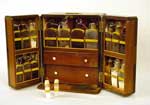 Doctor’s Medicine Chest
Doctor’s Medicine Chest
about 1850, reputedly once used by a ship’s captain, containing bottles of sulphate quinine, laudanum, sugar lead, lavender, opium, among other medicines. UWO Medical Artifact Collection #2004.127.01.01
 Surgical Set
Surgical Set
mid- to late-19th century, manufactured by Luer of Paris, containing 64 components including various saws, trephination drills, scalpels, amputation knives, and even eye surgery instruments. Once owned by Dr. Peter Stewart, it was donated by Dr. Charles Thompson, his great-grandson and Head of Opthalmology at Western. UWO Medical Artifact Collection #2004.147.01.01
 Amputation Set
Amputation Set
19th century, manufactured by George Tiemann and Co., New York, containing a tourniquet, several saws, and suture material. This set was probably owned by Dr. Septimus Thompson, grandson of Dr. Peter Stewart and father of Dr. Charles Thompson. Septimus Thompson specialized in ophthalmology and otolaryngology, and taught these subjects as the University of Western Ontario in the early 20th century. UWO Medical Artifact Collection # 2004.119.01.01
 Tooth Key
Tooth Key
early 19th century. Owned by Dr. S. McGarry of Niagara Falls, this key was donated to the Faculty of Medicine by a Dr. Glaister of Wellesley, Ontario. UWO Medical Artifact Collection #2004.387.01.01
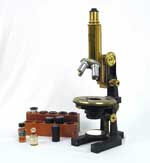 Monocular Compound Microscope
Monocular Compound Microscope
made in Germany by Carl Zeiss Jena with lenses from Spencer Lens Co., Buffalo, early 20th century, with interchangeable eye pieces and objective lenses. Distributed by the Eimer and Amend, Labratory (sic) Supplies, New York. UWO Medical Artifact Collection #2004.154.01.01
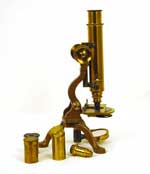 Brass Monocular Compound Microscope
Brass Monocular Compound Microscope
1870s, with interchangeable eye pieces and objective lenses. Donated to the Faculty of Medicine in 1922, it was used by William E. Waugh in his classes at McGill University under William Osler who was one of the first professors to teach diagnostics with microscopes. Waugh later became one of the first Professors of Medicine at the University of Western Ontario in the 1880s. UWO Medical Artifact Collection #2004.340.01.01
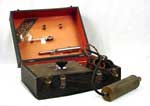 Ultraviolet Ray Machine
Ultraviolet Ray Machine
[Electrotherapeutics], made by Elco Instruments, Chicago, early to mid-20th century. UWO Medical Artifact Collection # 2004.001.01.01
 Medical Kit
Medical Kit
made in Germany, used in World War One, containing morphine, laudanum, valerian, and camphor. Captain Herbert C. Allison, graduate of the UWO Medical School and doctor to the 19th Canadian Battalion, B.E.F., found this kit in a German dugout at Vimy Ridge, and brought it home to Canada in 1917. A relative donated it to the Faculty of Medicine in the 1940s. UWO Medical Artifact Collection #2004.254.01.01
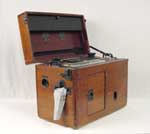 Cardiette
Cardiette
manufactured by Sanborn Company, Cambridge, Massachusetts, mid-20th century. It was made for Dr. Edward A. Bartram, a graduate of Western’s Medical School, and one of the first cardiologists in southwestern Ontario. UWO Medical Artifact Collection #2004.418.01.01
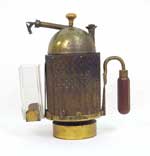 Lister Carbolic Spray
Lister Carbolic Spray
made by Godman and Shurtleff, Boston, late 19th century. The spray was given by Joseph Lister to a Dr. Taylor, who was his surgical dresser at the Glasgow Infirmary, and donated by his son Dr. A.H. Taylor. UWO Medical Artifact Collection #2004.082.01.01.
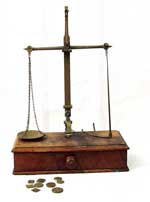 Apothecary Scale
Apothecary Scale
late 19th century, complete with weights, owned by Ninian Wildridge Woods, who received his M.D. from the University of Glasgow in 1842, and practiced in Bayfield, Ontario, after 1857. UWO Medical Artifact Collection #2004.138.01.01